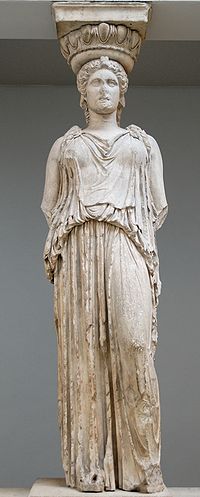
Clothing in ancient Greece
Encyclopedia
 |
Clothing in ancient Greece primarily consisted of the chiton
Chiton (costume)
A chiton was a form of clothing worn by men and women in Ancient Greece, from the Archaic period to the Hellenistic period ....
, the peplos
Peplos
A peplos is a body-lengthGreek garment worn by women before 500 BC. The peplos is a tubular cloth folded inside-out from the top about halfway down, altering what was the top of the tube to the waist and the bottom of the tube to ankle-length. The garment is then gathered about the waist and the...
, himation
Himation
A himation was a type of clothing in ancient Greece. It was usually worn over a chiton, but was made of heavier drape and played the role of a cloak.The himation was markedly less voluminous than the Roman toga....
, and chlamys
Chlamys
The chlamys was an ancient Greek piece of clothing, a type of cloak....
.
History and types
While no clothes have survived from this period, descriptions exist from contemporary accounts and artistic depiction. Clothes were mainly homemade, and often served many purposes (such as bedding). Despite popular imagination and media depictions of all-white clothing, elaborate design and bright colors were favored.The essential clothing for men and women was an inner tunic (peplos
Peplos
A peplos is a body-lengthGreek garment worn by women before 500 BC. The peplos is a tubular cloth folded inside-out from the top about halfway down, altering what was the top of the tube to the waist and the bottom of the tube to ankle-length. The garment is then gathered about the waist and the...
or chiton
Chiton (costume)
A chiton was a form of clothing worn by men and women in Ancient Greece, from the Archaic period to the Hellenistic period ....
) and outer cloak (himation
Himation
A himation was a type of clothing in ancient Greece. It was usually worn over a chiton, but was made of heavier drape and played the role of a cloak.The himation was markedly less voluminous than the Roman toga....
). The peplos was usually a heavier woollen garment, while the chiton was a lighter linen. Clothes were fastened with brooches or pins (fibulae), and a belt or girdle (zone
Zone (vestment)
The Zone ; occurs in Homer as a woman's girdle and can even refer to her waist itself. Classical Greek had a verb put a girdle around the loins, or "gird one's self."...
) might secure the waist. The upper part of the peplos was folded down to the waist to form an apoptygma. Either garment could be pulled up under the belt to blouse the fabric: kolpos
Kolpos
The kolpos is the blousing of a peplos, chiton or tunic in Ancient Greek clothing, whereby excess length of the material hangs folded over a zone ....
. A strophion was an undergarment sometimes worn by women around the mid-portion of the body, and a shawl (epiblema
Epiblema
Epiblema is a genus of moths belonging to the subfamily Olethreutinae of the family Tortricidae.-Species:*Epiblema abruptana *Epiblema absconditana *Epiblema acceptana...
) could be draped over the tunic. Men could don a short cloak (chlamys
Chlamys
The chlamys was an ancient Greek piece of clothing, a type of cloak....
). Men might wear a hat (petasos
Petasos
A petasos or petasus is a sun hat of Thessalian origin worn by the ancient Greeks, often in combination with the chlamys cape. It was usually made of wool felt, leather or straw, with a broad, floppy brim. It was worn primarily by farmers and travellers, and was considered characteristic of rural...
), women less commonly, and for outdoors, leather sandals or boots. Greek women wore one large piece of wool or linen, wrapped around them and pinned in various ways to make it stay.
Sources
- Metropolitan Museum: Ancient Greek Dress
- Georgia O'Daniel Baker, Helen R. Pullen, A Handbook of Costume Drawing: A Guide to Drawing the Period Figure for Costume Design Students, 2nd ed. Focal Press, 2000, ISBN 0240804031, 9780240804033

